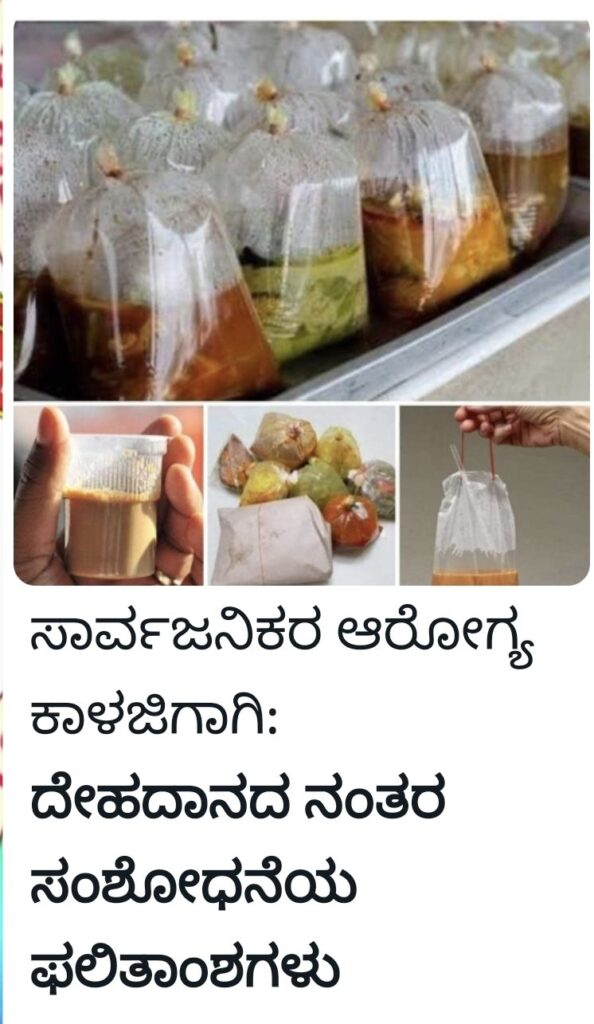
ಸಾರ್ವಜನಿಕರ ಆರೋಗ್ಯ ಕಾಳಜಿಗಾಗಿ:
*ದೇಹದಾನದ ನಂತರ ಸಂಶೋಧನೆಯ ಫಲಿತಾಂಶಗಳು*
36ರ ಹರೆಯದ ವ್ಯಕ್ತಿಯೊಬ್ಬರಿಗೆ ಕ್ಯಾನ್ಸರ್ ಇರುವುದು ಪತ್ತೆಯಾಗಿದ್ದು ಅದು ಕೊನೆಯ ಹಂತದಲ್ಲಿದ್ದಾಗ.
ಅವರ ಯೌವನದಲ್ಲಿ ಅವರು ಗುಟ್ಖಾ, ಸಿಗರೇಟ್, ಪಾನ್, ತಂಬಾಕು ಮತ್ತು ಮದ್ಯವನ್ನು ಸೇವಿಸಲಿಲ್ಲ. ಸಮಯಕ್ಕೆ ಸರಿಯಾಗಿ ಕೆಲಸಕ್ಕೆ ಹೋಗುತ್ತಿದ್ದರು, ಅವರಿಗೆ ಯಾವುದೇ ಕೆಟ್ಟ ಚಟಗಳಿರಲಿಲ್ಲ. ಸಂಸಾರದೊಂದಿಗೆ ಖುಷಿಯಾಗಿದ್ದರು. ಅವರಿಗೆ ಯಾವುದೇ ಕಾಯಿಲೆ ಇರಲಿಲ್ಲ, ಚಿಂತೆ ಇರಲಿಲ್ಲ.
ಕಿಬ್ಬೊಟ್ಟೆಯ ನೋವು ಪ್ರಾರಂಭವಾದ 2/3 ದಿನಗಳ ನಂತರ, ವೈದ್ಯರನ್ನು ಸಂಪರ್ಕಿಸಿ ಮತ್ತು ಚಿಕಿತ್ಸೆಯನ್ನು ಪ್ರಾರಂಭಿಸಿದರು ಆದರೆ ಯಾವುದೇ ಪ್ರಯೋಜನ ಆಗಲಿಲ್ಲ, ಅವರ ತಂದೆ ಹಿರಿಯ ವೈದ್ಯರನ್ನು ಭೇಟಿ ಮಾಡಿದರು ಮತ್ತು ಅಲ್ಲಿ ಅವರ ಎಲ್ಲಾ ವರದಿಗಳನ್ನು ತೋರಿಸಿದರು. ಅವರಿಗೆ ಹೊಟ್ಟೆ ಕ್ಯಾನ್ಸರ್ ಇದೆ ಎಂದು ತಿಳಿದುಬಂದಿದೆ.
ಚಿಕಿತ್ಸೆಯ ಸಮಯದಲ್ಲಿ ಮನೆ ಅಡಮಾನವಿಟ್ಟು ಚಿಕಿತ್ಸೆ ಪಡೆಯಲು ಪ್ರಾರಂಭಿಸಿದರು. ಆಭರಣಗಳನ್ನು ಮಾರಾಟ ಮಾಡಲಾಯಿತು, ಆದರೆ ಪ್ರಯೋಜನವಾಗಲಿಲ್ಲ. ಅವರು ನಿಧನರಾದರು.
ಆತನ ಅಂತ್ಯಸಂಸ್ಕಾರ ಮಾಡದಂತೆ ವೈದ್ಯರು ಕುಟುಂಬದವರಿಗೆ ಸಲಹೆ ನೀಡಿದರು. ಮಾನವ ಸೇವೆಗಾಗಿ ದೇಹದ ಬಗ್ಗೆ ಸಂಶೋಧನೆ ಮಾಡಲು ಆಸ್ಪತ್ರೆಗೆ ದೇಣಿಗೆ ನೀಡುವಂತೆ ತಿಳಿಸಿದರು. ಮತ್ತು ಅವರು ದಾನ ಮಾಡಿದರು.
ಸಂಶೋಧನೆಯ ನಂತರ, ಪ್ಲಾಸ್ಟಿಕ್ ಬಾಟಲಿಯ ನೀರು ಕುಡಿದ ಪರಿಣಾಮವಾಗಿ ಬಿಡುಗಡೆಯಾಗುವ ರಾಸಾಯನಿಕಗಳಿಂದ ಅವರಿಗೆ ಕ್ಯಾನ್ಸರ್ ಇರುವುದು ಕಂಡುಬಂದಿದೆ … ನಂತರ ವೈದ್ಯರು ಅವರ ಕುಟುಂಬ ಮತ್ತು ಸಹೋದ್ಯೋಗಿ ಗಳನ್ನು ಸಂಪರ್ಕಿಸಿ ಅವರ ಆಹಾರ ಪದ್ಧತಿಯ ಬಗ್ಗೆ ವಿಚಾರಿಸಿದರು. ಅವರು ದಿನಕ್ಕೆ ಐದರಿಂದ ಆರು ಬಾರಿ ಪ್ಲಾಸ್ಟಿಕ್ ಕಪ್ಪುಗಳಲ್ಲಿ ಚಹಾ ಕುಡಿಯುತ್ತಿದ್ದರು.
ಅವರು ಆರ್ಡರ್ ಮಾಡುವ ಚಹಾ ಪ್ಲಾಸ್ಟಿಕ್ ಚೀಲಗಳಲ್ಲಿ ಬರುತ್ತದೆ ಮತ್ತು ಪ್ಲಾಸ್ಟಿಕ್ ಕಪ್ಗಳಲ್ಲಿ ನೀಡಲಾಗುತ್ತದೆ ಎಂದು ಅರ್ಥವಾಯಿತು.
ಜನರು ಅಂಗಡಿಯಿಂದ ಬಿಸಿ ಚಹಾ, ತರಕಾರಿಗಳು, ಸೂಪ್ ಅಥವಾ ಇತರ ರೀತಿಯ ಆಹಾರ ಪದಾರ್ಥಗಳನ್ನು ಪ್ಲಾಸ್ಟಿಕ್ ಚೀಲಗಳಲ್ಲಿ ತರುತ್ತಾರೆ ಮತ್ತು ತಿನ್ನುತ್ತಾರೆ ಅಥವಾ ಕುಡಿಯುತ್ತಾರೆ, ಅವರು ನಿಧಾನವಾಗಿ ಅವರ ದೇಹದೊಳಕ್ಕೆ ಕ್ಯಾನ್ಸರ್ ಸೂಕ್ಷ್ಮಾಣುಗಳು ಪ್ರವೇಶಿಸಲು ಅವಕಾಶ ಮಾಡಿಕೊಡುತ್ತಾರೆ ಎಂಬುದನ್ನು ಪತ್ತೆ ಮಾಡಲಾಗಿದೆ.
ವೈದ್ಯರು ನಂತರ ಅವರ ಸಹೋದ್ಯೋಗಿಗಳ ವೈದ್ಯಕೀಯ ಪರೀಕ್ಷೆ ಮಾಡಿದರು. ಅವರ ಅನೇಕ ಸಹೋದ್ಯೋಗಿಗಳೂ ಕ್ಯಾನ್ಸರ್ ನಿಂದ ಬಳಲುತ್ತಿದ್ದಾರೆ ಎಂದು ಕಂಡುಕೊಂಡರು. ನಂತರ ವೈದ್ಯರು ಕ್ಯಾನ್ಸರ್ ಚಿಕಿತ್ಸೆಗೆ ಸಲಹೆ ನೀಡಿದರು.
ಪ್ಲಾಸ್ಟಿಕ್ ಬಳಕೆ ಪರಿಸರಕ್ಕೆ ಹಾನಿಕರ. ಕನಿಷ್ಠ ಪ್ಲಾಸ್ಟಿಕ್ ಚೀಲಗಳು, ಪ್ಲಾಸ್ಟಿಕ್ ಪಾತ್ರೆಗಳಲ್ಲಿ ಬಿಸಿ ಆಹಾರ ಸೇವಿಸಬೇಡಿ. ಹಾಗೆ ಮಾಡುವುದರಿಂದ, ನಾವು ನಮ್ಮನ್ನು ಮತ್ತು ನಮ್ಮ ಪ್ರೀತಿಪಾತ್ರರನ್ನು ಸಾವಿನ ಕಡೆಗೆ ತಳ್ಳುತ್ತಿದ್ದೇವೆ.
ಆದುದರಿಂದ ಪ್ಲಾಸ್ಟಿಕ್ ಬಳಕೆಯನ್ನು ಆದಷ್ಟು ಕಡಿಮೆ ಮಾಡಿ, ಪ್ಲಾಸ್ಟಿಕ್ ಚೀಲದಿಂದ ತಂದ ಚಹಾ ಕುಡಿಯಬೇಡಿ, ಪ್ಲಾಸ್ಟಿಕ್ ಅಥವಾ ಪೇಪರ್ ಲೋಟಗಳನ್ನು ಬಳಸದೆ ಬಿಸಿ ಚಹಾ-ಕಾಫಿ ಕುಡಿಯಲು ಪಿಂಗಾಣಿ, ಗಾಜಿನ ಅಥವಾ ಸ್ಟೀಲ್ ಲೋಟಗಳನ್ನು ಬಳಸಿ…..
ವಿಶೇಷ: – *ಇದು ನಿಜವಾಗಿ ನಡೆದ ಘಟನೆಯೇ ಹೊರತು ಕಥೆಯಲ್ಲ!*

What Do The Plastic Numbers Mean?
Every number stamped at the base of a plastic water bottle was done so intentionally and as such, has a purpose and meaning. Now that you are no longer wondering if plastic water bottles are safe, the next thing you are most likely wondering about is what these numbers on your plastic water bottles mean.
If a plastic bottle has any of these numbers, this is what it means;
#1: This is a Polyethylene Terephthalate (PET) plastic. This means that this is safe and healthy to be used as a drinking water bottle. These are also usually BPA-free plastic water bottles. An example of this is our Tritan plastic water bottle with straw.
#2: What this means is that this is High-density polyethylene (HDPE) plastic, which is commonly used to make juice bottles, milk jars, as well as some other beverages. If that’s the case, then it means plastics labelled with this number are safe.
#3: A plastic with label number 3 is considered unsafe for cooking. This type of plastic is called Polyvinyl chloride (PVC) and is used to make food wraps and also plumbing materials. Any PVC plastic should not be used in the heat for direct contact with food. That is, don’t use such plastics in a microwave to heat food as this is harmful to health.
#4: This is a Low-density polyethylene (LDPE) and is used in making things like food wraps, grocery bags, squeezable bottles, etc. This plastic type is considered relatively safe. That is, they are safe but not recyclable.
#5: This type of plastic is used to package some food items and beverages and is considered safe. This type of plastic is Polypropylene (PP). You can use this plastic to reheat things in a microwave, but as much as you can, transfer that food to another container before consuming it.
#6: Polystyrene or Styrofoam plastic is not at all safe for consumption. These types of plastics cannot be recycled, and also takes years before they can decompose. This plastic type is harmful to the environment, as well as to humans.
#7: This type of plastic can be regarded as “everything else”. This is so because these types of plastics are usually made by combining different types of plastics. These are best avoided for consumable use as you cannot tell what types of plastics have been combined to produce this. Also, they are considered toxic because most times they contain chemicals like BPA.
Which Plastic Number Is Safe?

Whenever you see the numbers labelled beneath your plastic water bottle, your brain goes into a frenzy mood trying to decipher what numbers are safe and what numbers aren’t. To save you
all that stress, the numbers which are considered safe plastics are 1, 2, 4 and 5. Anything outside of these is considered unsafe and unhealthy.
Is All Plastic BPA-Free Now?
Lately, many manufacturers are producing more and more BPA-free plastic water bottles. Nevertheless, not all plastics are actually BPA-free water bottles. Plastics that have the identification numbers 1,2,4 or 5 are what are considered safe as they are BPA-free.
You can purchase any of our BPA-free water bottles right here. At fj, we are concerned about your health and ensure to only offer you safe plastic water bottles. Some of our best BPA0free water bottles are; the vacuum-insulated kids’ water bottle 14 oz; the 25 oz stainless steel insulated light water bottle and many others.
When you purchase one of our reusable plastic water bottles, you are guaranteed of buying quality that won’t in any way tamper with your health.
Reusing plastic water bottles can be such a scare, especially if you don’t know what plastic type was used to produce that item or if you can’t interpret what the numbers mean. However, you can put all that uncertainty behind you when you purchase safe plastic water bottles from our

RELATED ARTICLES
EVERYTHING YOU NEED TO KNOW ABOUT CARBONATED DRINKS
November 8, 2023
HOW DO YOU GET RID OF THE WEIRD TASTE IN YOUR WATER BOTTLE?
November 8, 2023
Teach you to make sparkling water at home
October 15, 2023
How does nuclear energy contribute to water pollution?
September 18, 2023
DISCUSSION ON TAP WATER POLLUTION AND DRINKING WATER HEALTH
September 17, 2023
IS TITANIUM GOOD FOR WATER BOTTLES?
July 21, 2023
The Health Benefits of Drinking Water from Stainless Steel Bottles
June 26, 2023
How to Clean and Maintain Your Reusable FJ Bottle for Optimal Hygiene
June 26, 2023
LEAVE A COMMENT
Your email address will not be published. Required fields are marked *Name *Email *Comment *
Please note, comments must be approved before they are published
Get in touch
Support
Global Store
Customer Service
Newsletter Signup








United States Australia — Australia France United StatesAlabamaAlaskaAmerican SamoaArizonaArkansasArmed Forces AmericasArmed Forces EuropeArmed Forces PacificCaliforniaColoradoConnecticutDelawareWashington DCMicronesiaFloridaGeorgiaGuamHawaiiIdahoIllinoisIndianaIowaKansasKentuckyLouisianaMaineMarshall IslandsMarylandMassachusettsMichiganMinnesotaMississippiMissouriMontanaNebraskaNevadaNew HampshireNew JerseyNew MexicoNew YorkNorth CarolinaNorth DakotaNorthern Mariana IslandsOhioOklahomaOregonPalauPennsylvaniaPuerto RicoRhode IslandSouth CarolinaSouth DakotaTennesseeTexasUtahVermontU.S. Virgin IslandsVirginiaWashingtonWest VirginiaWisconsinWyoming
